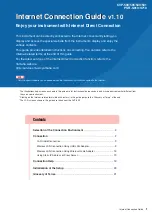
KDFX Reference
KDFX Algorithm Specifications
10-25
Page 3
Wet/Dry
Wet/Dry sets the relative amount of wet signal and dry signal. The wet signal
consistts of the reverb itself (stereo) and the delayed mono signal arriving after
the reverb has ended (simulating the dry source in the reverse reverb sequence).
The amount of the delayed signal mixed to the Wet signal is separately
adjustable with the Dly Lvl control. The Dry signal is the stereo input signal.
Out Gain
This controls the level of the output mix, wet and dry, sent back into the K2661.
Fdbk Lvl
This controls the feedback gain of the separate, (mono) delay tap. A high value
contributes a long repeating echo character to the reverb sound.
HF Damping
HF Damping adjusts a low pass
fi
lter in the late delay tap feedback path so that
high frequencies die away more quickly than mid and low frequencies.
Dly Lvl
This adjusts the level of the separate, (mono) delay tap used to simulate the dry
source of a reverse reverb effect. This same tap is used for feedback.
Dly Length
Sets the length (in milliseconds), of the separate, (mono) delay tap used to
simulate the dry source of a reverse reverb effect. This same tap is used for
feedback.
Rvb Env
The Rvb Env control selects 27 cases of envelope gains for the taps. Nine cases
emulate a normal forward evolving reverb, another nine emulate a reverb
building symmetrically to a peak at the mid point, while the last nine cases
emulate a reverse building reverb. For each major shape, there are three
variants of one, two, and three repetitions and three variants of envelope
sharpness.
Rvb Length
Sets the length (in milliseconds), from start to
fi
nish, of the reverberation
process. This parameter is essentially the decay time or RT60 for the Rvb Env
cases ..R1.. where there is only one repetition.
Bass
Early, Mid, and Late. These bass controls shape the frequency response (boost
or cut) of the three periods of the
fi
nite reverb sequence. Use them to tailor the
way the reverb bass content changes with time.
Damp
Early, Mid, and Late. These treble controls shape the frequency response (cut
only) of the three periods of the
fi
nite reverb sequence. Use them to tailor the
way the reverb treble content changes with time.
Early Bass
-15 to 15 dB
Early Damp
16 to 25088 Hz
Mid Bass
-15 to 15 dB
Mid Damp
16 to 25088 Hz
Late Bass
-15 to 15 dB
Late Damp
16 to 25088 Hz
Summary of Contents for K2661
Page 18: ...2 4 LFOs LFO Shapes...
Page 34: ...3 16 DSP Algorithms...
Page 54: ...5 4 MIDI Note Numbers Note Numbers for Percussion Keymaps...
Page 72: ...7 10 System Exclusive Protocol K2661 System Exclusive Implementation...
Page 82: ...9 4 Upgrading Sample Memory Choosing and Installing a SIMM for K2661 Sample Memory...
Page 334: ...10 252 KDFX Reference KDFX Algorithm Specifications...
Page 340: ...11 6 Glossary...
Page 382: ...12 42 Triple Modular Processing Alphanumeric Buttonpad Entries for DSP Functions...
Page 392: ...B 6 SysEx Control of KDFX MSB and LSB...
Page 442: ...D 20 Contemporary ROM Block Objects Controller Assignments Contemporary ROM Block...
Page 490: ...H 12 General MIDI Standard Mode Controller Assignments...
Page 492: ...I 2 Live Mode Objects Live Mode Programs...
Page 498: ...K2661 Musician s Reference Index...
Page 500: ......
















































